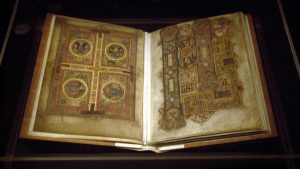15 Answers to the Riddles
Michael Amey
Riddle 1
The answer is a helmet. The thing that is “rough” that fills the helmet is the hair of the man wearing the helmet.
Riddle 2
This riddle – with its reference to a “boneless wonder” that rises and that is grabbed by “the proud-hearted” bride – is meant to guide the listener to a sexual answer, but the more likely answer is much more mundane. The woman is making dough. Dough rises, and the woman covers the rising dough with a cloth.
Riddle 3
Wob, twisted around the right way, is bow. The “battle-sting” is a kenning for an arrow. Bows that do not have their bow strings “do not obey any man”.
Riddle 4
This riddle, like Riddle 2, is deliberately sexual. It sounds as if the young man who “thrusts” “something stiff” through “her girdle” is impregnating a woman. It helps to remember that in Old English, as in many modern European languages, all words had grammatical gender. In this case, the word used to describe the object the man is working with is a feminine noun – a butter churn. The “something stiff” is a plunger. The man churns butter – “a hero’s reward for laying on dough”.
Riddle 5
The answer is fire. Flint and steel are the “two dumb creatures” that give birth to fire. A carefully maintained fire “brings warm blessings,” but a poorly watched fire can burn down a house.
Riddle 6
The answer is an onion. Onions stand in garden beds and are “shaggy below”. An onion doesn’t harm anyone “except its slayer alone” in that when a cook cuts into an onion the cook often cries.
Riddle 7
The “warrior” in this riddle is a shield, which takes all the blows from the enemy.
Riddle 8
This final riddle provides an in-depth description of how a sacred text, like a Bible, would have been made. It is important to remember that paper and printing presses did not exist in Anglo-Saxon England. All books were manuscripts. The word manuscript combines to Latin words – manu meaning hand, and script meaning written. Thus, all the books of the time had to be laboriously handwritten. That alone was labor intensive and meant that books were rare and expensive items. Beyond the cost of writing a book out by hand, one also had to take into account the cost of sheep that had to be killed so that their hides could be turned into parchment.
This riddle goes through the book-making process. First sheep or other animals must be killed. The hides are removed and soaked in water and then laid out to dry. The fur is taken off, and any blemishes to the skin are scraped away with a sharp knife. Once the parchment is ready, it is folded to create a quire, or multiple pages. The scribe would use ink made from various ingredients and a quill to write the book. Then book would be bound between two boards. These boards would be covered with a leather hide and the cover would be decorated.

